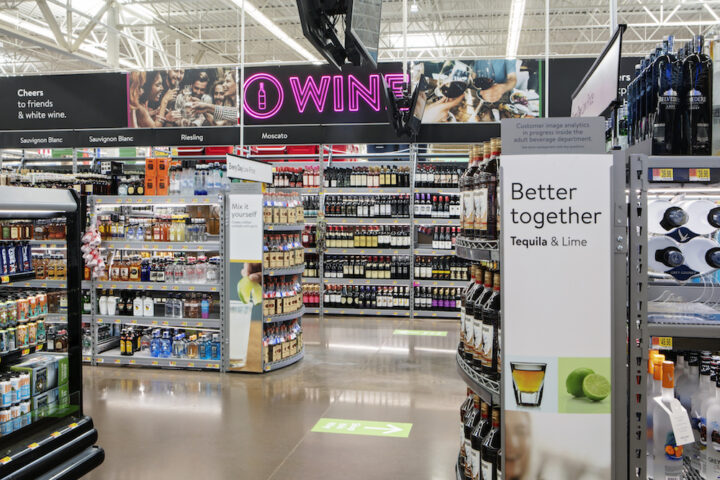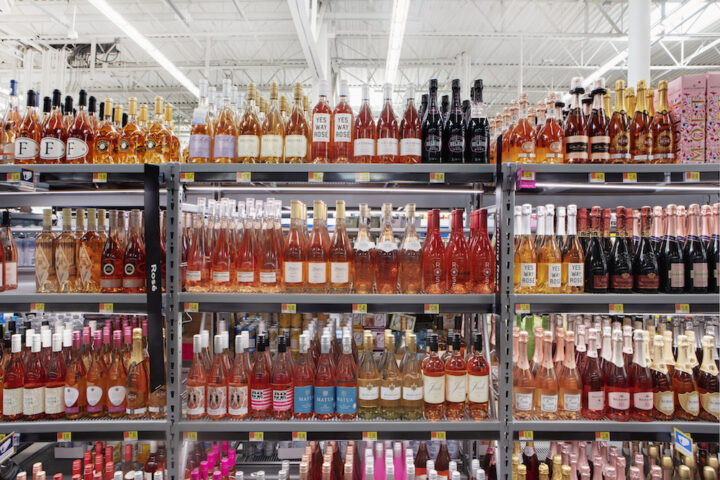
Walmart is well-known for its value proposition. A focus on offering savings to customers is inherent in virtually everything the massive retail chain sells, and beverage alcohol is no exception. But beyond cost savings on beer, wine, and spirits, Walmart has recently been focusing on another type of savings—one that has prompted the retailer to expand its range of offerings.
“Our customers are really focused on saving time,” says Jason Fremstad, vice president for adult beverage at Walmart, who was named a Market Watch Leader in 2013. “One way we help save our customers’ time is by making sure they find what they need when they’re shopping with us, both in-store and online. Over the past year and a half or so, that really has meant ensuring that we have a broad assortment across beer, wine, and spirits.”
Walmart is not only offering more variety, it’s changing the way beverage alcohol brands are merchandised in-store. “We’re really committed to transforming the customer experience,” Fremstad says. “Our goal is to physically make the adult beverage department distinctive within the store so that we can make our emphasis on price, assortment, and convenience very clear to our customers, and also combine it with aesthetics that draw attention to enhance our product offerings. For us, this means redesigning the look and feel of our adult beverage department by refreshing the lighting, flooring, and shelving. We want our customers to walk by and see the difference.”
For his efforts to enhance the product selection and create a memorable shopping experience for customers, Fremstad has been awarded the Market Watch Leaders Alumni Award for Best Marketing in 2020.

Upping The Assortment
When a chain like Walmart decides to expand its assortment, it causes a big ripple in the world of beverage alcohol retail. The Bentonville, Arkansas-based retail behemoth has more than 4,700 stores in the U.S. alone, the vast majority of which sell beverage alcohol. Walmart is tight-lipped on details regarding the range of beer, wine, and spirits it sells, but Fremstad says each category has an increased presence in the chain. “For competitive reasons, we don’t share category specific SKU counts, but from a consumer perspective I can tell you that Walmart has significantly expanded the assortment of beer, wine, and spirits we offer customers,” he says. “Five years ago, our customers likely would not have found local craft beers, premium wines and spirits, or trendy items like hard seltzers and alcoholic ice pops in their store. Today, all of these items and more are among our expanded assortment.”
Fremstad left Walmart in 2014 to pursue other industry opportunities, but rejoined the company in February 2019. Upon his return, Fremstad says he found the chain over-reliant on core items. “Our customers have shown us time and time again that core items are incredibly important to us, but we’re not meeting all the expectations of the trip,” he says. “If I’m a customer, I need to go to buy my core items but I also need to buy the wine that I want for my Friday night dinner.” Fremstad explains that, on a store-by-store basis, he’s been making sure to utilize insights to best cater to customer interests. “That way, we can assort that store in such a way that customers walk in and realize they can get anything they want for any occasion at an everyday low price,” he says, adding that the same is done with the beverage alcohol section of the Walmart website. “That’s really been our mission for the last year and a half. It’s all about giving our customers the assortment they want, no matter the occasion.”

Store Within A Store
Walmart’s increased assortment of wine, spirits, and beer SKUs needed room to spread out. Earlier this year, the company began transforming the beverage alcohol sections of its stores, with the goal of giving those offerings “the proper amount of space to carry the level of assortment needed now to compete in the adult beverage market,” Fremstad says. He wants customers to be able to easily find products and be pleasantly surprised by an expanded selection that previously would have required a separate trip to a specialty store.
Fremstad points to the chain’s remodeled Branson, Missouri store, where the beverage alcohol section has been completely revamped. Metal shelving holds wine and spirits, organized by category, while endcaps showcase featured products. Massive aisle-length coolers hold an expanded selection of beer, spritzers, and other RTD products.

“It’s clear, clean merchandising—I think we really got the lighting and fixtures right,” Fremstad says. “Our approach was to make it efficient, but at the same time enjoyable. We didn’t want to be over the top; we just wanted to make sure we were investing in what our customers wanted, which is clean, well-lit, well-signed areas focusing on the products.”
The space devoted to beverage alcohol is more than doubled in the Branson store. That’s not the case at all locations, Fremstad says, but wherever possible, stores will be receiving upgrades in the coming months and years. “It’s a store-specific execution, so not all of them are going to double in size, but all are seeing an expansion in space, which allows us to expand into both more premium categories as well as in things like craft beer, while at the same time making sure that we’re covering the core in stock,” he says. “Customers have responded incredibly well to the store so far.”
Walmart began its store remodels earlier this year. “Unfortunately, we’re not as far along as we wanted to be because Covid-19 delayed the remodels,” Fremstad notes. “But we’re back on track now. We’ll have a fairly large number done this year, but our chain is so big that it takes a long time to make a visible impact. We’re looking toward to next year and we’re doing our best to secure the internal approvals needed to keep moving and hopefully speed up the process a bit.”
Fremstad adds he’d like to see the remodels occur throughout the chain. “I don’t think we’ll be able to do it in every store, but we certainly want to do it wherever possible,” he says, adding that, based on current projections, he expects to bring the new look to approximately 500 stores a year. In addition to the store-within-a-store expansions, Walmart is also trying to enhance the experience for those who choose not to enter the store at all. Online shopping at Walmart is on the rise, and it accelerated due to the Covid-19 pandemic and subsequent stay-at-home orders in most markets. “More customers shop for groceries online, and we want to make sure they have the same convenience as in-store shopping,” Fremstad says. Currently, about half of the chain’s stores offer adult beverage items for pickup, and a few offer delivery.
Customers can also order products via Walmart’s app; the company recently combined its general app with its grocery app. “We recently made our online shopping experience more convenient for customers by making it easier to find,” Fremstad says, adding that the beverage alcohol section has improved so that it’s easier to navigate.

Local Approach
More space and more SKUs allow Walmart to curate a selection of wine, beer, and spirits that is unique to a region or individual store. This includes a nod to regional preferences as well as a focus on local products that enhance the core range. “We’re hyper-focused on local,” Fremstad says. “We’re at a point now where we are quite close to having store-specific modular, or a source-specific assortment, in every single category.
In the beer category, for example, Walmart has significantly expanded its craft beer offerings, tapping into the enthusiasm for local products. Walmart partners with local breweries to offer in-demand items to customers, a policy that accelerated when closures due to the pandemic put those local businesses at risk.
Fremstad says the new, expanded range carried at Walmart “allows us to get really deep into craft beer assortment, and it’s the same for wine and spirits.” From a wine standpoint, he explains, the company has improved at representing regional wineries and assessing what customers are seeking from a regional standpoint. “What a California customer is looking for is different from what a customer is looking for in Missouri,” he adds, noting that while the Branson store sees a lot of customer interest in Bourbon, stores in California see more interest in lighter spirits like Tequila. The move to embrace local products still relies on Walmart’s centralized ordering structure. Rather than bring in specific items directly, store personnel contact the adult beverage team at Walmart’s headquarters to make suggestions.

Communication with customers also happens through the company’s headquarters, and typically isn’t specific to beverage alcohol. Fremstad says a team within the corporation brings insights directly from customers, but the adult beverages division has no direct contact with customers, except occasionally at the store level. In addition to that internal information-gathering process, Fremstad says he relies on insights from suppliers, distributors, and individual store employees. “Our store leadership is great at giving us feedback on what we’re doing well, not doing well, or missing out on,” he says.
The feedback on the expanded assortment and new store-within-a-store concept has been extremely positive, especially with customers, and Fremstad says that sales are strong within the adult beverage sector. Covid-19, which prompted sales spikes for many beverage alcohol retailers, didn’t cause any significant changes in approach at Walmart. “I can’t say that the pandemic has had a massive impact on how we approach the business,” Fremstad says.
“It’s been very clear that the same three things continue to matter most to customers: price, assortment, and stock,” he adds. “We are very proud to have everyday low pricing, unlike other retailers, and we’ve done our best to keep up with stock by partnering with distributors and suppliers and understanding what we can do to stay ahead of the level of demand that’s coming in.”
Fremstad will continue to maintain those values throughout and after the public health crisis. “The pandemic has magnified those values, but our job has always been to take care of our customers,” he says. “Whether they’re in our stores or online, we have to make sure we have what they want when they want it. For us, more than anything else, it’s been validation that those are the most important things to be working on.”